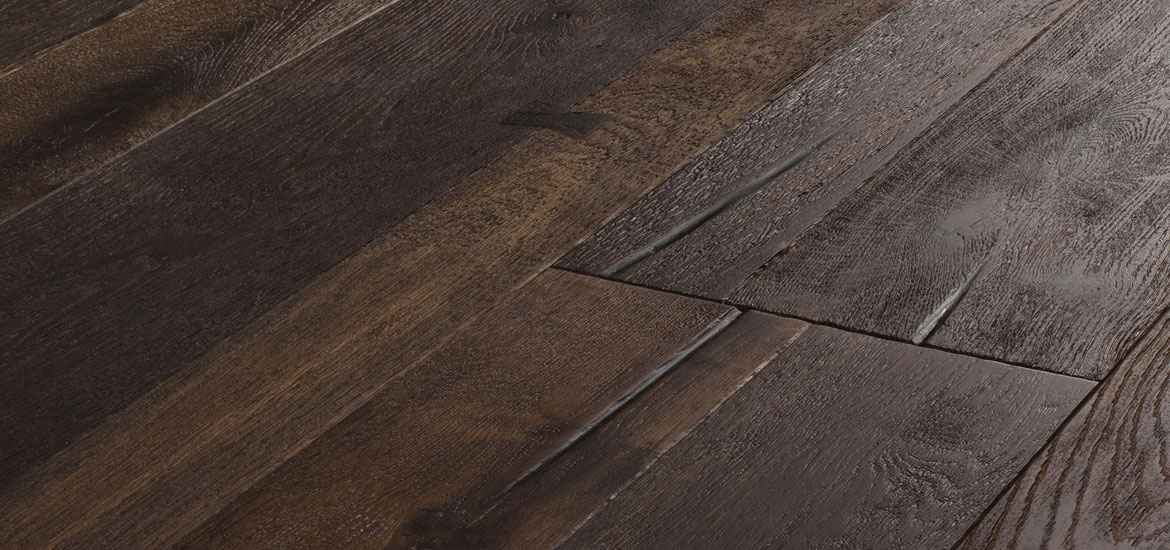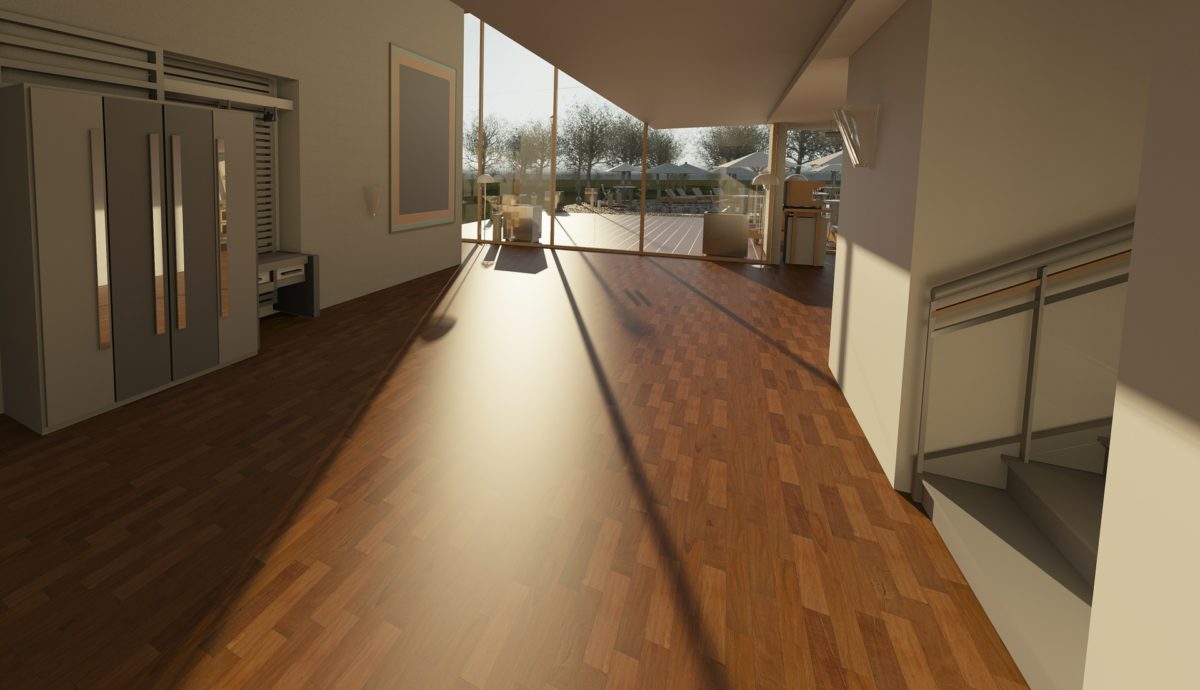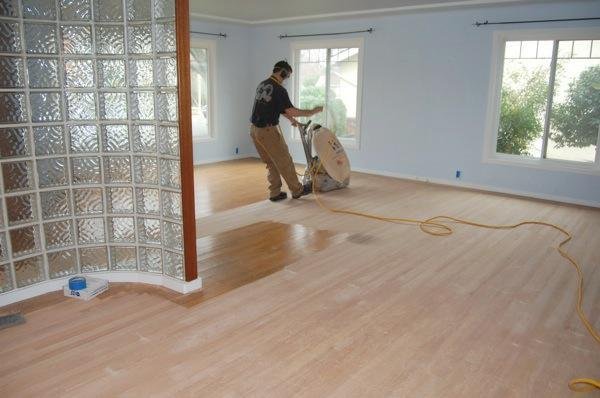Flooring trends change from year to year as homeowners acquire new tastes and technology allows a larger variety of flooring designs for their remodeling project. In 2016, dark hues struck the right note with homeowners. Flooring finishes ranging from jet black to light gray became very popular. Another trend that picked up and could continue into next year is allowing flooring imperfections such as the grain and pockmarks to serve as part of the aesthetics and create a more natural feel. It was also a big year for faux flooring. Tiles that look like wood were especially in trend. 2017 is bound to bring with it new and exciting trends. With insights from industry experts, we have highlighted the 8 top flooring design trends we are likely to witness in 2017.
1. Fumed Wood Flooring – Stronger Color and Grain
Almost all types of wood flooring undergo some kind of staining to give them the desired final finish. Fumed wood flooring gets its rich color and grain without having to get any sort of staining. Instead, the wood is put through a process called fuming. This involves placing the wood in a chamber where airborne ammonia is then released. The wood reacts with the ammonia and undergoes a color change. The reaction does not always result in the exact same changes. The final patina achieved depends on a number of factors including the type of wood, the outside environment and the atmosphere in the chamber itself. So even among two similar pieces of wood, the resulting hues may vary. Generally, however, fuming gives the wood rich dark tones and enhances the natural grain of the wood. The final look is much more appealing and feels deeper than what you get with stained wood flooring. Do not confuse fumed wood with that which has had liquid ammonia directly applied onto it. Using liquid ammonia directly on the wood risks damaging the fiber and could weaken its structure. Do plenty of research if you plan to use fumed wood flooring. Since shades vary from wood to wood, make sure you look around enough until you get the perfect flooring that will work best for your home.
2. Bleached and Blanched Woods

Not everyone likes the glossy brown stains of most wooden floors. For some, the softer white-washed look of a bleached floor is more their taste. This kind of flooring consists of wood that has undergone a bleaching process, also called blanching. This involves applying a chemical solution onto the surface of the wood to get rid of the “color”. By color, we mean the artificial dye or stain coating the wood. Blanching gives the wood an ashy white-washed look with the natural wood grain still being clearly visible from underneath. So you do not lose the charm and beauty of natural wood, it is just packaged in another style. Take a look at our home remodeling ideas page, which is full of our previous project pictures. If you are planning a renovation, make sure you ask your contractor which option is better for you; bleaching your current wood flooring or replacing it with ready-made blanched flooring. Trying to give your current wood flooring the bleached look is often expensive and tedious work. The 2017 bleached and blanched trend is going to be especially popular in modern urban decors–especially in homes where an industrial style is favored. This look can work great in full industrial decors, futuristic rooms and can be even integrated in country or farmhouse homes.
3. Distressed Wood and Concrete Tiles
The distressed floor style has been around for quite a while but has become even more popular just recently. Next year, expect to see more homeowners opt for that luxury aged look in their flooring. Distressed flooring undergoes artificial aging and styling processes that gives it a slightly worn finish. It works best for spaces where a beautiful rustic look is desired. In preparing distressed wood flooring, various actions are taken depending on the degree and style of “distress” desired. The edges of each wood plank are hand scrapped, swirl and kerf markings are added to imitate historic wood and the planks are brushed to remove glossing and give them a soft worn texture.
If wood flooring is not your cup of tea, you can also opt for the increasingly popular distressed concrete flooring. In 2017, the distressed concrete floor style will receive more attention as homeowners look for alternatives to traditional wood flooring. As with distressed wood, distressed concrete goes through artificial processes to minimize the highly polished look and produce an enhanced worn out patina. Distressed concrete flooring can be integrated into most types of decors but works best in industrial and contemporary home styles.
4. Wide Planked Rustic Wood Looking Tiles

When it comes to wood-looking tiles, there is increased focus on rustic designs. More and more homeowners want realistic designs with warm natural looks. This is why vintage and distressed finishes are getting more popular. In 2017, wide planked rustic wood looking tiles are expected to grace more homes. The wide planks will help add to the authentic wood look and perfectly complement the rustic finish. If you have a flooring renovation in the works, this is a great choice. It will leave your home with the homely and cozy feeling of real wood while giving you the easy maintenance and durability of tile.
5. Textured Ceramic Tiles
All of us are very familiar with smooth and shiny ceramic tiles–a description that often relegates them to practical rather than decorative uses. But if you have been thinking of adding a unique twist to one of the spaces in your home, you can now add ceramic tiles to your list of stylish flooring options. 2017 brings with it a new face for ceramic tiles. It does not have the polished sheen you would expect and does not have the usual glasslike smoothness. Textured tiles are officially here and you should not miss out. These tiles have been designed to resemble other materials, not just in look but also texture. The 2017 ceramic wood grain tile will be almost indistinguishable from actual wood. The tile will resemble wood in terms of color and even grain pattern. When you walk on it, the texture will be very close to the real thing. You can even install ceramic floor tiles that look like sandstone in almost all aspects. Thanks to advanced technology, homeowners today can get a wide variety of flooring styles just from ceramic tiles. This simple tile can be manipulated and styled to produce an endless variety of designs, shapes, sizes and textures.
6. Vintage Makes a Comeback
Vintage has always been about nostalgia–bringing back the warmth and memories of decades past. In 2017, vintage black and white tiles will make a comeback. But it is not the same old black and white tiles that adorn historic homes. More and more homeowners want a unique twist to the vintage flooring style. This includes smaller tiles with bolder graphic patterns. This perfectly blends vintage with contemporary for the perfect look and feel.
7. Reclaimed Barn Wood Tiles, Multi-toned and Directional

The 2017 reclaimed barn wood flooring trend is an extension from the faux wood tiles flooring trend so popular in 2016. The barn wood look will be a favorite because of its rustic grain and distressed look. For homeowners who are looking for a warm country look, this is something to consider. Technology has become so good that manufacturers can replicate the exact look of real wood onto the tile surface. This makes it almost impossible to differentiate the tile from real wood. We might even see multi-toned tiles to give a space more character. For more “wood” authenticity, these tiles will have a directional finish, resembling that of real barn wood. Tiles that look like wood provide homeowners with much more variety when determining their flooring options. No longer do you have to resort to traditional hardwood to achieve that warm and cozy feel to your home. With faux tiles, you get the design benefits of a hardwood floor while also enjoying the functional advantages of tile flooring. Thanks to technology, homeowners will have even more options next year and in coming years. Tiles that resemble wood in terms of color, look and even texture will become commonplace.
8. Graphic Tiles
Not many people are willing to use their flooring as an art canvas. But if you love unique and artful patterns on your tiles, graphic tiles are coming in full force. Using advanced technology, manufacturers are able to replicate an endless variety of images on tiles. You can get tiles with repeating patterns or get tiles that, like a jigsaw puzzle, join together to form one large pattern on your floor. Graphic tiles come in monochromatic colors but if you are feeling particularly wild, there are others that come in bold multicolored patters and writings.
Conclusion
The general feeling going into 2017 is that no one is satisfied anymore with traditional materials. Homeowners want flooring materials that have been given special treatment to make them unique in design and texture. Whether it is fumed wood, blanched flooring, textured tile or wood looking tiles; buyers are looking for new and exciting options. Fortunately, 2017 delivers on quality, variety, style and so much more. It will not disappoint.
Original Source by Bryan Sebring









